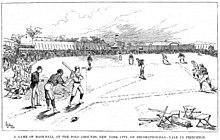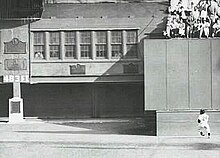Polo Grounds
They had started the season in a new facility called Metropolitan Park, which proved to be such a poor venue that they moved back to the Polo Grounds within a few weeks.
Governor David B. Hill, who had campaigned for office on a "home rule" pledge, vetoed it on the grounds that whatever he might think of the forced destruction of the park, the will of the city government was to be respected.
[15] Bill Jenkinson's modern research indicates the ball traveled about 500 feet (150 m) in total, after clearing the Polo Grounds double decked right field stand.
The Players' League Giants built Brotherhood Park in the northern half of Coogan's Hollow, next door to Polo Grounds II, otherwise bounded by rail yards and the bluff.
[17] In the very early morning hours of Friday, April 14, 1911, a fire of uncertain origin swept through the stadium's horseshoe-shaped grandstand, consuming wood and leaving only steel uprights in place.
Giants owner John T. Brush decided to rebuild the Polo Grounds with concrete and steel, renting Hilltop Park from the Highlanders during reconstruction.
The famous photo of The catch made by Willie Mays in the 1954 World Series against Vic Wertz of the Cleveland Indians occurred immediately in front of the "batter's eye", a metal screen atop the grandstand wall directly to the right of the centerfield runway.
The Polo Grounds was the site of one of the most iconic moments in baseball history – the historic "Shot Heard 'Round the World" walk-off home run on October 3, 1951 that decided the hard-fought National League pennant playoff series between the Giants and their cross-town rivals, the Brooklyn Dodgers.
[20][21] On July 4, 1950, Bernard Doyle, a resident of Fairview, New Jersey, in his 50s, originally from Dublin, Ireland, was struck and killed by a stray bullet while in his seat at the Polo Grounds.
[3] After both of those plans fizzled, the Giants announced on August 19, 1957 that after 74 years of professional baseball in New York, they would relocate to San Francisco, California at the end of the season, following their long-time rivals Dodgers to the West Coast.
In 1961, the city of New York decided to claim the land under eminent domain, for the purpose of condemning the stadium and building a high-rise housing project on the site.
[28][29] The final sporting event played at the Polo Grounds was on December 14, 1963 when the now renamed AFL team New York Jets lost to the Buffalo Bills 19–10.
In the 1992 book The Gospel According to Casey, by Ira Berkow and Jim Kaplan, it is reported (p. 62) that in 1963, Mets manager Casey Stengel, who had bittersweet memories of his playing days at the Polo Grounds, had this to say during a rough outing to pitcher Tracy Stallard, whose greatest claim to fame had been giving up Roger Maris' 61st homer in 1961: "At the end of this season, they're gonna tear this joint down.
The final iteration of the Polo Grounds was demolished in 1964,[1][2] beginning on April 10 with a wrecking ball bomb painted to look like a baseball, the same one that had been used four years earlier on Ebbets Field.
Stephen McNair, a Dodger fan, grabbed a sledge hammer as easily as Johnny Mize picked up a bat, marked off the left field fence beneath Section 33, and vowed, "I'm going to take that place down myself."
The Indians' bus passed the site in the midst of demolition while Cleveland was playing the Yankees: Dick Donovan, eyeing the rubble, remarked, "Boy, they must have had a helluva game there last night.
However, after the team's first practice, the 1919 schedule, that began with an opening day game against the Massillon Tigers, was scratched because of conflict with New York's blue laws.
An upset victory by the visiting University of Notre Dame over Army in 1924 led to Grantland Rice's famous article about the Irish backfield, which he called "The Four Horsemen".
The New York Giants soccer team took the field in all-white uniforms with black socks and played six games before the threat of a rival baseball league being formed diverted the owner's attention away from their new venture and caused it to be suspended mid-season.
On August 6 of the same year, 25,440 patrons showed up at the Polo Grounds to watch the inaugural International Soccer League Final which saw Bangu of Brazil edge out Kilmarnock FC of Scotland 2–0.
The only time an All-Ireland Senior Final has been played outside Ireland, it was the Gaelic Athletic Association (GAA)'s commemoration of "Black '47", the worst year of the Great Famine.
In Game 1 of the 1954 World Series, Giants outfielder Willie Mays made a sensational catch of a fly ball hit by the Cleveland Indians' Vic Wertz into deep center field, a catch which, in the words of NBC television sports announcer Jack Brickhouse, "must have looked like an optical illusion to a lot of people", and which turned the tide of that Series in the Giants' favor.
[48][49] The Giants' Hank Leiber hit a long fly ball to deep center field that DiMaggio caught in the runway, perhaps 430–440 from the plate, and his momentum carried him partway up the clubhouse steps.
[50] Babe Ruth hit many of his early signature blasts at the Polo Grounds, reaching the center field seats on several occasions.
[56] Bobby Thomson's "Shot Heard 'Round the World" that won the 1951 National League pennant for the Giants was hit over the left field fence.
But arguably the best-remembered home run hit to the right side was the walk-off three-run shot by Dusty Rhodes, batting for Monte Irvin in the 10th inning of Game 1 of the 1954 Series, after Mays' catch had kept the Giants tied.
It just barely cleared the fence, above the outstretched glove of the leaping outfielder Dave Pope, leading Al López, manager of the heavily favored Indians, to attribute the Giants' stunning victory in the Series opener to the ballpark's unusual dimensions.
[58] Anyone seated on the bench was offered some measure of protection from the elements by what has been variously described as an awning,[59] a canopy,[60] or simply the top of the bullpen, as Pittsburgh sportswriter Les Biederman put it when, two years after the ballpark's demolition, he reminded readers that this had been the landing spot for Roberto Clemente's first major league home run.
[61] The only part of the Polo Grounds that still remains is the "John T. Brush Stairway",[62] which runs down Coogan's Bluff from Edgecombe Avenue to Harlem River Driveway at about 158th Street.
When the stadium was built, Horace Stoneham, owner of the San Francisco Giants, had the original Polo Grounds light poles shipped there.




















